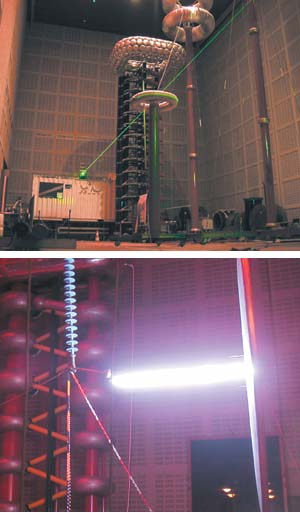

Stealing
Celestial Fire
A
laser has sparked artificial lightning in a laboratory,
a first step toward controlling real thunderbolts
There
has to be a better way of tapping a lightning bolt than flying
a kite in a storm, and a group of French and German scientists
just may have found one. They have demonstrated in a
laboratory that shining powerful laser pulses between
two electrodes elicits a controllable form of lightning.
They hope that their invention will eventually help to
fend off lightning strikes on airports and power stations.
They
employed their Teramobile laser, whose pulse lasts for a mere
100 femtoseconds and packs a peak power of 5 terawatts. The
pulse rips the electrons from air molecules, creating
a plasma; it also changes the refractive index of the
air, a phenomenon called the Kerr effect. The effect
focuses the light just enough to balance plasma-induced
diffraction, creating a straight and highly conductive
channel, called a filament, which can stretch up to 3.8
meters between the charged electrodes.
In the
experiment, a 1- to 2-megavolt electrode simulates a thundercloud
and an electrically grounded plate simulates the earth.
The laser-induced filaments short-circuit the electrodes,
triggering an electric discharge much like a lightning
bolt. To complete the simulation, the researchers sprayed
water between the electrodes. "We expected that the 'rainwater'
would scatter light and perturb the filaments, but the
filaments survived the interaction," says Jérôme
Kasparian, a lead investigator and a member of the group
from the University of Lyon, in France. Another team
hails from the École Polytechnique, in Palaiseau,
France; two others come from the Free University of Berlin
and the Friedrich Schiller University, in Jena, Germany.
 The main problem is the plasma's milliseconds-long
life, which limits the distance between the two electrodes
to 10 meters. Kasparian says that the research groups
hope to keep the plasma going longer by heating it with
a second laser. Still, they are far from getting filaments
that could span the 5 to 6 kilometers separating a thundercloud
from the earth.
The main problem is the plasma's milliseconds-long
life, which limits the distance between the two electrodes
to 10 meters. Kasparian says that the research groups
hope to keep the plasma going longer by heating it with
a second laser. Still, they are far from getting filaments
that could span the 5 to 6 kilometers separating a thundercloud
from the earth.
FILAMENT
OF FIRE: The Teramobile laser [right] shoots pulses from
a shed to the space between an electrode charged by a generating
tower and a grounded electrode [not shown]. The pulse
ionizes the air, creating a conductive filament. Artificial
lightning follows the filament's straight path [below].
Scientists
have tried and failed to manipulate lightning with lasers
for 20 years. One reason, Kasparian says, is that all experiments
so far have employed lasers with relatively long pulses
of high energy, which create plasmas so dense that they
scatter the laser light, preventing the formation of
a filament. The Franco-German team solved this problem
with the Teramobile, the first mobile laser ever to
emit ultrashort pulses of moderate energy. The titanium-sapphire
laser was designed to track air pollution by analyzing
light that bounces off atmospheric gases, but the researchers
realized that it could also provide lightning "on demand."
Matters
don't seem that simple to Martin Uman, director of the Lightning
Research Laboratory at the University of Florida, in
Gainesville. Every summer for 11 years, he and his group
have launched about 70 rockets trailing grounded wire
into thunderclouds, drawing lightning half the time.
"The cloud charges itself back up in about 10 seconds.
You don't know if you're going to put the rocket [or
the laser beam] in the right place," he says. "Firing
lasers or rockets is not going to make any difference
to what's going on up there. You probably have to go
a step further back and understand the physics behind
it."
To understand
lightning, however, you need to be able to produce it reliably
and frequently, and here lasers might have advantages
over rockets. Typical rocket racks allow only up to 10
launches, Kasparian points out, while the laser technique
could provide a "virtually unlimited number of shots"
at triggering lightning.
If lasers
ever write glowing lines high in the sky, it should be possible
to control the course of lightning bolts. Then people
will not merely talk about the weather, but do something
about it.
—PRACHI
PATEL PREDD
PHOTOS:
KAY RETHMEYER/TU BERLIN/TERAMOBILE

 The main problem is the plasma's milliseconds-long
life, which limits the distance between the two electrodes
to 10 meters. Kasparian says that the research groups
hope to keep the plasma going longer by heating it with
a second laser. Still, they are far from getting filaments
that could span the 5 to 6 kilometers separating a thundercloud
from the earth.
The main problem is the plasma's milliseconds-long
life, which limits the distance between the two electrodes
to 10 meters. Kasparian says that the research groups
hope to keep the plasma going longer by heating it with
a second laser. Still, they are far from getting filaments
that could span the 5 to 6 kilometers separating a thundercloud
from the earth. 